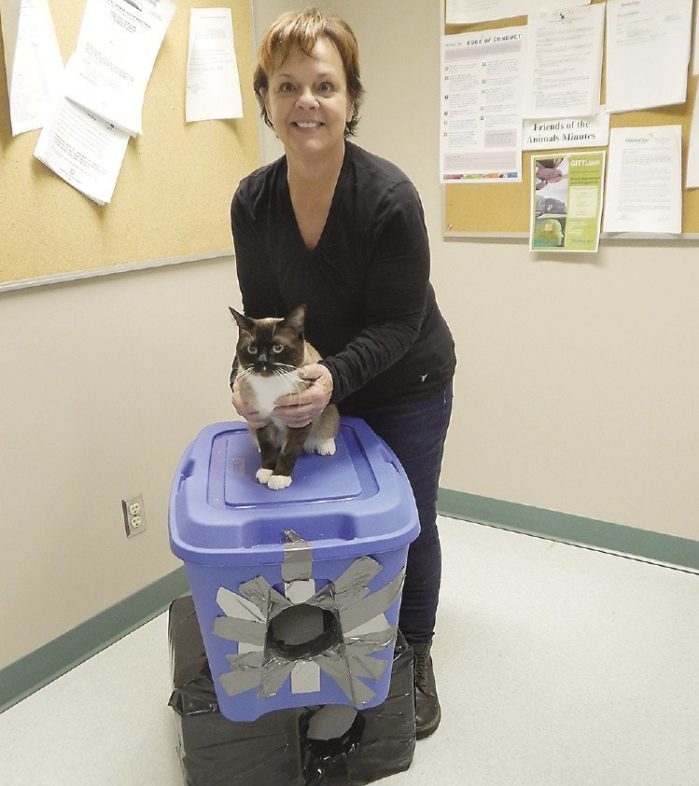Sonny is friendly, gregarious. In fact, given the chance, Sonny will climb all over any human near enough to say howdy to. He is orange and white, with a purr like a well-tuned Ferrari engine. Yes, he’s a cat, and a very lucky one. Sonny is lucky not because he has one life short of 10, but because he had a comfy temporary home with Thunder Bay Animal Services. For others not so lucky, there is Caring Hearts Cat Rescue and Sanctuary.
“Caring Hearts is a volunteer-run organization that rescues homeless cats where possible,” says Michelle Gagnon, founder of the rescue. “We vet them all and try to rehome them.”
Cats without human homes sometimes form groups called colonies on the edges of towns and cities. Individuals may suffer disease, starvation, exposure or even fall prey to foxes, coyotes or lynx. Despite these challenges, homeless cats can reproduce prodigiously and impact local wildlife. Then there are the cats who were family pets but are no longer wanted, for whatever reason, and dropped off at animal shelters such as Thunder Bay’s Animal Services, or with Caring Hearts. Either way, the life of a homeless domestic cat can be a desperate, difficult one, a situation that Caring Hearts Rescue and Sanctuary has sought to address.
“Since about the middle of 2015, we have dealt with over 1,000 cats,” Gagnon adds. “We also build winter shelter boxes for community cats.”
In November 2019, over 30 public and Caring Hearts volunteers participated in a winter shelter box build.
“We modify plastic storage tubs, make an entrance hole in the end and add some straw so that a cat or maybe two or three have a temporary shelter from extreme weather,” says Amber Raine, as their co-adoption coordinator. “We also make shelters out of Styrofoam coolers, all duct-taped together. We built about 40 of them. Most of them are being used.”
“We work with Superior Street Cats. They operate a trap, sterilize and release program for cat colonies,” Gagnon says. “Caring Hearts does not release cats back into the wild, but seeks to have them adopted.”
Caring Hearts began with Gagnon taking care of a colony on the outskirts of Thunder Bay. Through her efforts and the work of other volunteers, Caring Hearts was formed, with its first cat sanctuary on Onion Lake Road.
“We also have sanctuaries off Pike Lake Road and behind the City Dump on Gratton Road,” Gagnon says. “We’ll pick up cats from the city outskirts and northern communities. We even get pregnant mothers—10 this year already—cats from ditches, back yards, everywhere. People bring them in, too. Lots of surrenders are in pretty bad shape.”
A cat brought in by Caring Hearts is cared for in a private room in a foster home, where it stays until a veterinarian checks it for health status, gives first vaccinations and deworming done, and medicines as needed. The vet will be watching for signs of feline leukemia and/or other diseases. After three weeks, the cat will get booster shots, and at an age-appropriate time, be sterilized. If the cat is okayed by the vet, then comes the process of advertising through social media and word of mouth, of another candidate for adoption. This process may take some time.
“We’re always looking for fosters,” says Amber. ”These people are often students here for the school term or snowbirds. Some fosters even wind up adopting.”
“Due to an overabundance of cats in the north, we sometimes will coordinate with North Bay Humane Society, where all cats are adopted quickly,” says Gagnon. “They send a 35-foot trailer, complete with heat, AC and proper crates for these trips.”
“We’re always looking for volunteers and donations and adoptive homes,” she adds. “And we fundraise constantly to pay the costs of the vets. Many of the intake cats were sick this year or had birth damage or infections. One set of kittens needed $1,300 for its meds.”
“The adoption fee is $300,” Amber says. “That’s $162 less than getting all the procedures done yourself. A lot of people tell us that that’s a reasonable price, and you know you’re getting a healthy pet.”
How effective is a program of sterilization and adoption? Some 15 years ago, Thunder Bay Animal Services euthanized over 1,500 cats and dogs in a year. Through the efforts of Caring Hearts rescue, Kitty Kare and others, by 2018, that number had dropped to 11 dogs and some 100 cats, the latter being too ill to adopt out. Part of the wall by the Animal Services entrance is a photo gallery of dozens of cats and dogs labeled by name, and with a sign, “We Were Adopted!”
“We go through a lot of emotions when we do this work,” Gagnon reflects. “It’s rewarding when you can rescue a cat from a ditch and get them to a new home. But it’s sad when they pass away.”
Sonny has little to worry about on that score, however. Halfway through the interview for this article, the Animal Services receptionist came to retrieve him. His adoptive family was here to take him to his new home. Sonny has graduated.






